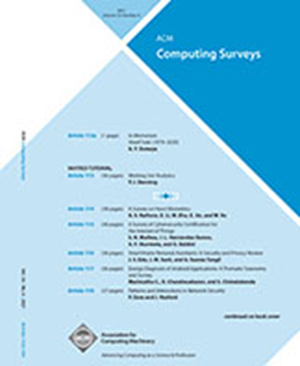A Survey on Hypergraph Mining: Patterns, Tools, and Generators
IF 23.8
1区 计算机科学
Q1 COMPUTER SCIENCE, THEORY & METHODS
引用次数: 0
Abstract
Hypergraphs, which belong to the family of higher-order networks, are a natural and powerful choice for modeling group interactions in the real world. For example, when modeling collaboration networks, which may involve not just two but three or more people, the use of hypergraphs allows us to explore beyond pairwise (dyadic) patterns and capture groupwise (polyadic) patterns. The mathematical complexity of hypergraphs offers both opportunities and challenges for hypergraph mining. The goal of hypergraph mining is to find structural properties recurring in real-world hypergraphs across different domains, which we call patterns. To find patterns, we need tools. We divide hypergraph mining tools into three categories: (1) null models (which help test the significance of observed patterns), (2) structural elements (i.e., substructures in a hypergraph such as open and closed triangles), and (3) structural quantities (i.e., numerical tools for computing hypergraph patterns such as transitivity). There are also hypergraph generators, whose objective is to produce synthetic hypergraphs that are a faithful representation of real-world hypergraphs. In this survey, we provide a comprehensive overview of the current landscape of hypergraph mining, covering patterns, tools, and generators. We provide comprehensive taxonomies for each and offer in-depth discussions for future research on hypergraph mining.求助全文
约1分钟内获得全文
求助全文
来源期刊

ACM Computing Surveys
工程技术-计算机:理论方法
CiteScore
33.20
自引率
0.60%
发文量
372
审稿时长
12 months
期刊介绍:
ACM Computing Surveys is an academic journal that focuses on publishing surveys and tutorials on various areas of computing research and practice. The journal aims to provide comprehensive and easily understandable articles that guide readers through the literature and help them understand topics outside their specialties. In terms of impact, CSUR has a high reputation with a 2022 Impact Factor of 16.6. It is ranked 3rd out of 111 journals in the field of Computer Science Theory & Methods.
ACM Computing Surveys is indexed and abstracted in various services, including AI2 Semantic Scholar, Baidu, Clarivate/ISI: JCR, CNKI, DeepDyve, DTU, EBSCO: EDS/HOST, and IET Inspec, among others.
 求助内容:
求助内容: 应助结果提醒方式:
应助结果提醒方式:


